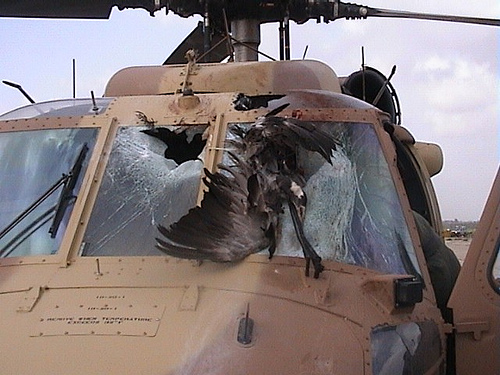Strike Out
Yes, our avian brothers committed feathered mayhem in Alfred Hitchcock’s 1963 classic The Birds, but is that any reason they should continue to be chucked into aircraft engines?Here’s the deal: All aircraft have to pass certification tests proving that the airplane can continue operating in the eve…

Yes, our avian brothers committed feathered mayhem in Alfred Hitchcock’s 1963 classic The Birds, but is that any reason they should continue to be chucked into aircraft engines?
Here’s the deal: All aircraft have to pass certification tests proving that the airplane can continue operating in the event of a bird-strike. The certification process divides the bird population into small-, medium- and large-size. Small birds can weigh up to 3.2 ounces, medium-size birds up to 2.5 pounds, and large birds over 2.5 pounds (a Canada goose can easily weigh 12 pounds).
The most common way to conduct the test is to shoot dead birds (usually chickens or geese) into an aircraft engine to see if the engine can still produce thrust. As William Langewiesche described in the June 2009 issue of Vanity Fair (“Anatomy of a Miracle”), “In real time the birds pass almost instantaneously through the test engines. They go in whole and emerge as spray. Animal advocates have objected to this.”
How much of a problem are bird-strikes, anyway? They’re actually a huge concern to commercial and military aviation; it is estimated that they cost U.S. commercial aviation more than $1 billion each year in aircraft damage and lost revenue caused by delays. The U.S. Air Force alone experiences about 2,500 bird-strikes annually. (Military aircraft are more vulnerable as they tend to travel at lower altitudes where birds fly.)
The first known aircraft fatality caused by a bird, according to a 2002 study by Navjot Sodhi, published in the American Ornithologists’ Union journal The Auk, “occurred in 1912, when a gull (Larus sp.) was caught in the control cables of an aircraft, causing it to crash.”
And it’s only gotten worse.
Sodhi reports that faster, wide-body aircraft receive more bird-strikes than older, narrow-body jets: “With the wider bodied aircraft, birds have to fly twice as far to escape than they do for the older small-bodied aircraft.”
Is it really necessary to use actual birds for engine testing?
At certain stages of aircraft development, artificial birds are used in place of the real thing, but more often, the birds are...actual birds, slaughtered right before testing. (Langewiesche notes: “There is a concern among some engine specialists that the farm-raised test birds being used today are themselves unrealistic, because they are flabby compared with their wild brethren, who seem to cause more damage than test birds of the same weight.”)
But help is on the way. BAE Systems in London is working on an advanced computer simulation to take the place of actual birds, at least during some tests. According to Stuart McCallum of BAE Systems, there is plenty of debate about the merits of using artificial versus actual birds in testing. “It varies depending on a number of factors such as impact angle, target shape and material,” he wrote to us by email.
BAE uses physical artificial birds (made of gelatin) for testing, as well as a computer representation of a Canada goose. “The shape of these birds are often cylinders, representing the torso of the bird. They do not account for the neck and wings of a Canada goose, in contrast to the computer representations which do,” says McCallum.
The cost, however, is minimal. “Physical artificial birds are not too expensive to produce,” says McCallum, “being based largely on gelatin. The current computer simulation model took some time to develop, but since it’s a computer representation we can use it to analyze impacts with aircraft continually, with no recurring costs.”
Ultimately, it’s the certification authorities that will decide if artificial birds—or a computer model—can take the place of actual birds. “We need to prove that artificial birds are representative of real birds if they are to be used in the ‘final’ qualification tests,” says McCallum.